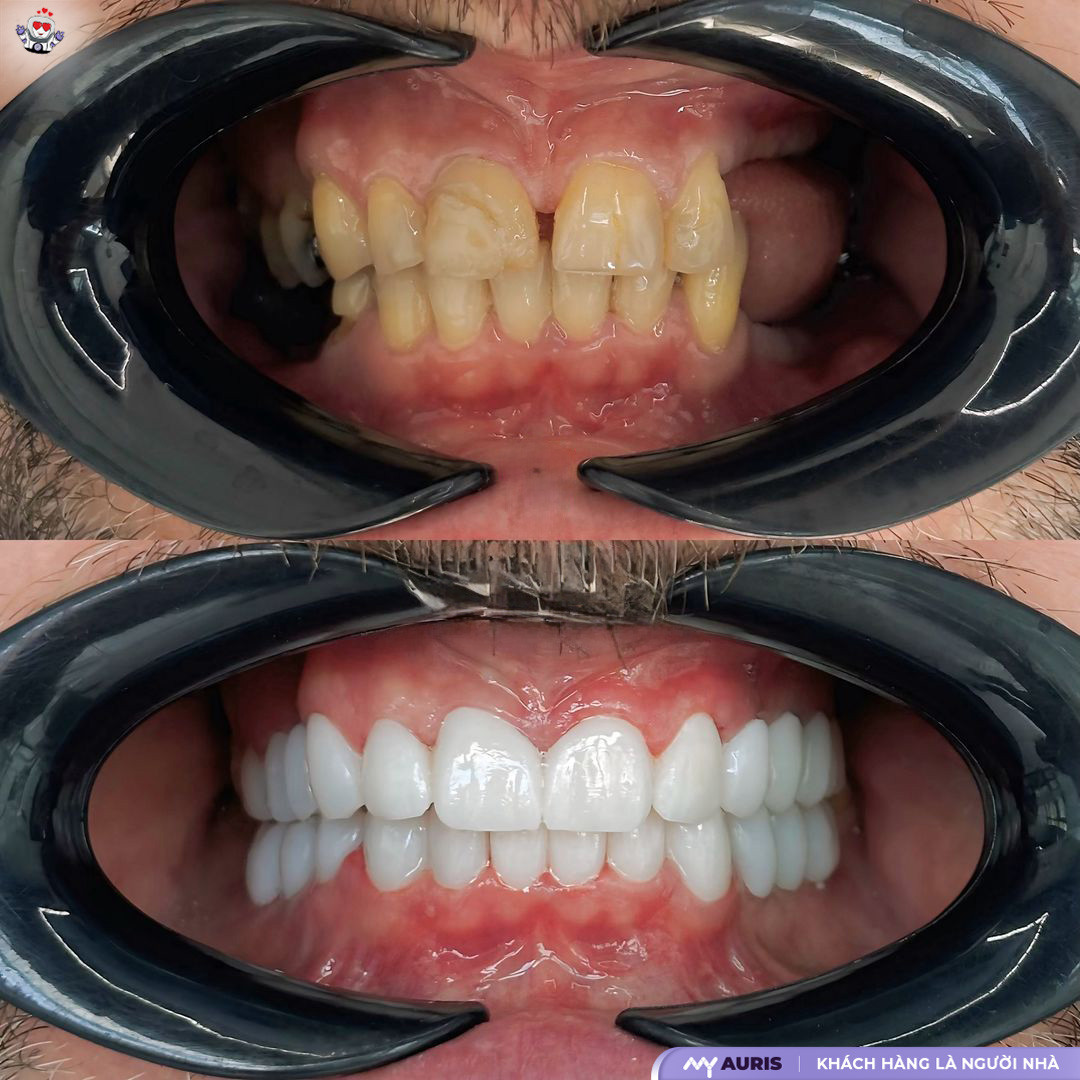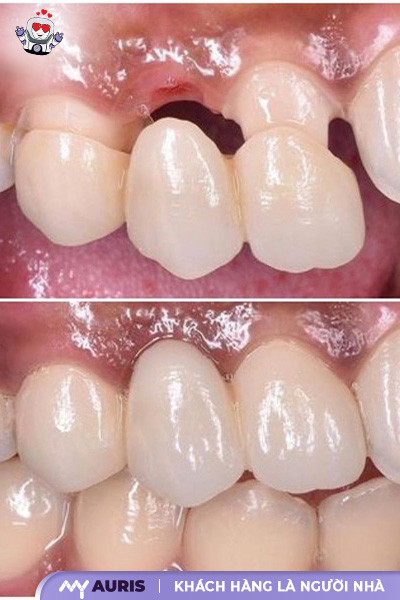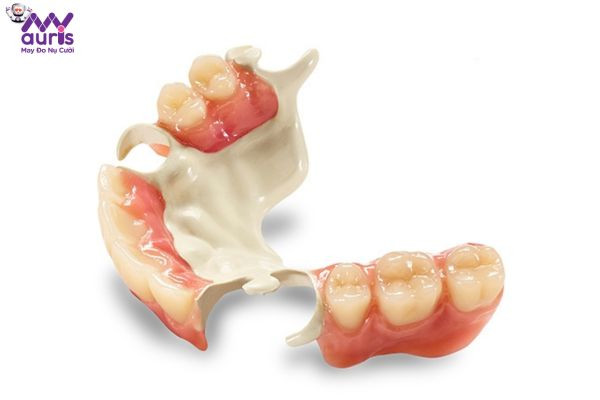Are you worried that losing molars will cause your cheeks to sink, affecting your facial aesthetics? Many people experience changes in facial structure, with sunken cheeks after tooth loss, especially molars. This article by My Auris will explain the connection between molar loss and the phenomenon of sunken cheeks, and provide effective dental restoration solutions.
The Connection Between Molar Loss and Sunken Cheeks
Molar loss directly impacts the jawbone and surrounding tissues. When a tooth is gone, the jawbone in that area no longer bears chewing forces. This lack of chewing stimulation causes the jawbone to gradually resorb, reducing its volume, leading to sunken cheeks and affecting aesthetics. This process occurs subtly, but the consequences of tooth loss are distinct, altering facial structure and making the face appear older.
Jawbone Resorption – The Main Cause of Sunken Cheeks
Jawbone resorption is the process where the jawbone gradually loses density and volume. This is the primary cause of sunken cheeks after tooth loss. Why does bone resorption occur after tooth loss? The direct connection between the tooth root and the jawbone plays a crucial role. The tooth root stimulates the jawbone to grow and remain healthy through chewing forces. Losing a tooth means losing this stimulation, causing the jawbone to gradually resorb. An abnormally fast rate of bone resorption can be due to tooth loss caused by rare diseases.
The natural process of bone resorption after tooth loss occurs over time. The longer a tooth is lost, the more severe the bone resorption, and the more noticeable the sunken cheeks. This explains why many people, after long-term tooth loss, often face difficulties with dental restoration, sometimes even requiring sinus lift surgery to increase jawbone volume before receiving dental implants.

The Role of Chewing Force in Maintaining Jawbone Structure and Cheek Tissues
Chewing force exerted on teeth during eating plays a crucial role in maintaining jawbone structure and cheek tissues. Chewing force stimulates jawbone growth, keeping the jawbone strong and preventing bone resorption. When teeth are lost, chewing force decreases, the jawbone is no longer adequately stimulated, gradually resorbs, causing sunken cheeks and affecting chewing function. The cheek tissues are no longer as plump as before, leading to severe psychological impact due to sunken cheeks. Therefore, maintaining proper chewing force is an important factor in preserving jawbone health, preventing sunken cheeks, and maintaining facial aesthetics.
Factors Affecting the Degree of Cheek Hollows After Molar Loss
Molar loss leads to sunken cheeks, affecting facial aesthetics. The degree of sunken cheeks depends on many factors. This article will specifically analyze key factors, provide dental restoration solutions, and help you regain plump cheeks and a balanced face.
Position of Lost Tooth (Molar #6, #7 Compared to Molar #8)
The position of a lost tooth significantly impacts changes in facial structure. Losing molars #6 and #7, located in crucial positions on the dental arch supporting the cheek muscles, causes more noticeable sunken cheeks compared to losing molar #8 (wisdom tooth). Molar #8 has less impact on facial aesthetics. This difference is related to the chewing function and supportive position of each tooth. The loss of molars #6 and #7 reduces jawbone volume, directly affecting the cheek muscles, causing the cheeks to sink in. Conversely, molar #8 is less involved in the chewing process, so its loss rarely causes sunken cheeks. Depending on the position of the lost tooth, the dentist will recommend an appropriate dental restoration solution.
Number of Missing Teeth and Duration of Tooth Loss
The greater the number of missing teeth and the longer the duration of tooth loss, the greater the degree of jawbone resorption, leading to more severe sunken cheeks. Losing one tooth can cause alveolar bone resorption, but losing multiple teeth increases the rate of bone resorption, spreading throughout the entire jawbone. Prolonged tooth loss means the jawbone is not stimulated by chewing forces, leading to faster bone resorption. Early dental restoration is an effective measure to prevent sunken cheeks.
Influence of Age and Jawbone Condition
Age and jawbone condition affect the rate of bone resorption and the degree of sunken cheeks. Older individuals, with reduced jawbone density, are more susceptible to bone resorption than younger people. Jawbone health conditions, such as osteoporosis and jawbone diseases, also influence the degree of sunken cheeks after tooth loss. The dentist will assess the jawbone condition, age, and overall health to propose a suitable dental restoration method, ensuring effectiveness and safety. Treatment costs will also be clearly communicated.

Does Wisdom Tooth Extraction Cause Sunken Cheeks?
Wisdom tooth extraction does not cause sunken cheeks because the tooth’s position does not affect cheek muscle support. The jawbone in the wisdom tooth area is less affected by chewing forces, so wisdom tooth extraction does not cause jawbone resorption or alter facial shape.
Wisdom teeth erupt late, often without enough space to develop, and are positioned eccentrically in the oral cavity. Unlike other molars, wisdom teeth are less involved in chewing function, so their extraction has little effect on chewing force, jawbone structure, or cheek tissues. Wisdom teeth can cause complications and may need to be removed to protect oral health.
In some exceptional cases, complex wisdom tooth extraction, involving significant invasion of the jawbone, can cause swelling, pain, affect jawbone structure, and lead to temporary sunken cheeks. This condition usually improves after healing.
Impact of Molar Loss on Health and Aesthetics
Impaired Chewing Function and Overall Health
Tooth loss, especially molars, directly affects chewing function. Molars play a crucial role in grinding food, facilitating the digestive system. When molars are lost, the ability to chew food effectively decreases, causing difficulties in digestion, leading to stomach and digestive system problems. Overall health is also affected because the body does not absorb enough nutrients. Food choices are also limited, impacting psychological well-being and quality of life.
Impact on Facial Aesthetics and Premature Aging
Molar loss causes alveolar bone resorption, altering facial structure, leading to sunken cheeks and an unbalanced face. Plump cheeks and a balanced face are important factors for aesthetic beauty. Molar loss accelerates facial aging, making the patient look older than their age.
Other Complications: Tooth Shifting, Bite Changes
Beyond sunken cheeks and premature aging, molar loss also causes many other complications. Teeth surrounding the missing tooth tend to shift, leading to an unbalanced bite. Bite changes affect chewing function, causing headaches and temporomandibular joint disorders. The position of the tooth, duration of tooth loss, number of missing teeth, and jawbone density all influence the severity of these complications. In some cases, tooth loss due to rare diseases can lead to one-sided sunken cheeks or an abnormally rapid rate of bone resorption, requiring restoration with special materials. The severe psychological impact of sunken cheeks is also a concern. The natural process of bone resorption after tooth loss is inevitable.
Missing Tooth Restoration Methods to Prevent Sunken Cheeks

Dental Implant Placement Prevents Jawbone Resorption
Dental implant placement is the optimal solution. Implants replace the tooth root, integrate into the jawbone, prevent bone resorption, and maintain jawbone and facial structure. Dental implants help increase bone volume, promote healthy jawbone development, and ensure chewing function and facial aesthetics. This method provides long-lasting results, almost like natural teeth. Although the cost of implant treatment is higher than other methods, its effectiveness and durability are superior.

Dental Bridge
A dental bridge replaces missing teeth by attaching a bridge to adjacent teeth. This method helps improve facial aesthetics and supports chewing. However, a dental bridge does not completely prevent jawbone resorption. Dental bridges can affect adjacent teeth because they need to be prepped to serve as abutments.

Removable Dentures
Removable dentures replace missing teeth, support chewing, and improve aesthetics. However, their effectiveness in maintaining jawbone structure is limited. Removable dentures can cause discomfort, feel cumbersome, and affect speech and taste sensation.

Optimal Time and Methods for Recovery After Molar Loss
Early intervention after tooth loss is key to preventing bone resorption, maintaining a healthy jawbone, and increasing cheek tissue volume. The ideal time is within the first 6 months after tooth loss. Early dental restoration helps the digestive system function well, promotes healthy bodily development, and prevents complications of tooth shifting.
After tooth extraction, especially molars #6, #7, or wisdom teeth (#8), the jawbone begins to resorb. This natural process of bone resorption occurs rapidly in the initial months. Therefore, early restorative intervention is crucial. The longer the duration of tooth loss, the more the jawbone density decreases, affecting the restoration process and treatment costs.
Choosing a dental restoration method depends on the position of the lost tooth, the number of missing teeth, jawbone condition, oral health, and cost. The dentist will advise on the most optimal solution, ensuring facial aesthetics and chewing function:
Dental Implants: The optimal solution. Implants replace the tooth root, prevent bone resorption, maintain jawbone structure, directly integrate with the jawbone, and help the jawbone develop. Implants offer long-lasting effectiveness, high aesthetics, and improved chewing function and jawbone health.
Dental Bridge: A solution to replace missing teeth by bridging onto adjacent teeth. Dental bridges have a lower cost than implants but may require grinding down adjacent teeth and offer more limited effectiveness in preventing bone resorption.
Removable Dentures: A temporary solution with low cost and limited effectiveness in preventing bone resorption. Removable dentures can cause discomfort while chewing and affect aesthetics.
Care and Prevention of Sunken Cheeks After Molar Loss
Nutrition plays a vital role in maintaining jawbone density and overall health. After tooth loss, dietary habits need to be emphasized more than ever.
Supplement Calcium and Vitamin D: Calcium is the main component of bones, and Vitamin D helps the body absorb calcium effectively. Milk, cheese, yogurt, salmon, and eggs are rich sources of calcium and vitamin D. You can also consult your doctor about supplementing calcium and vitamin D with dietary supplements.
Increase Magnesium and Zinc: Magnesium supports calcium absorption, and zinc aids bone development. Nuts, whole grains, and dark leafy greens are good sources of magnesium and zinc for jawbone health.
Limit Sugary and Acidic Foods: Sugar and acid increase the risk of tooth decay and gum inflammation, negatively affecting jawbone health. Limit sweets, carbonated soft drinks, and processed foods.
Drink Enough Water: Water helps keep the oral cavity clean, supports the digestive system, and aids the absorption of nutrients for the human body.
Besides nutrition, daily lifestyle habits also affect oral and jawbone health.
Proper Oral Hygiene: Brush your teeth at least twice a day with a soft-bristled toothbrush and fluoride toothpaste. Use dental floss to clean between teeth, removing plaque and bacteria.
Gum Massage: Gently massaging your gums helps increase blood circulation, keeps gums healthy, and reduces the risk of alveolar bone resorption.
Avoid Chewing Overly Hard Foods: Overly hard foods can put pressure on the jawbone, especially after tooth loss. Choose soft, easy-to-chew foods to reduce pressure on the jawbone and remaining teeth.
Do Not Smoke: Smoking reduces blood flow to the gums, causing inflammation and increasing the risk of bone resorption.
Regular dental check-ups are an important measure to maintain oral health and detect early problems with teeth and jawbone.
Regular Dental Check-ups Every 6 Months: The dentist will check the condition of your teeth, gums, and jawbone, detecting early signs of bone resorption and other problems.
Consultation on Dental Restoration Solutions: If you have missing teeth, the dentist will advise on suitable dental restoration solutions such as dental implants, dental bridges, or removable dentures to prevent sunken cheeks, maintain chewing function, and facial aesthetics. Treatment costs depend on the restoration method and oral condition.
X-rays: X-rays help assess the condition of the jawbone, detecting potential issues that cannot be seen with the naked eye.
Proper oral care, combined with a sensible diet and regular dental check-ups, will help you maintain oral health, prevent sunken cheeks, preserve plump cheeks and a balanced face, ensuring chewing function and overall health.





